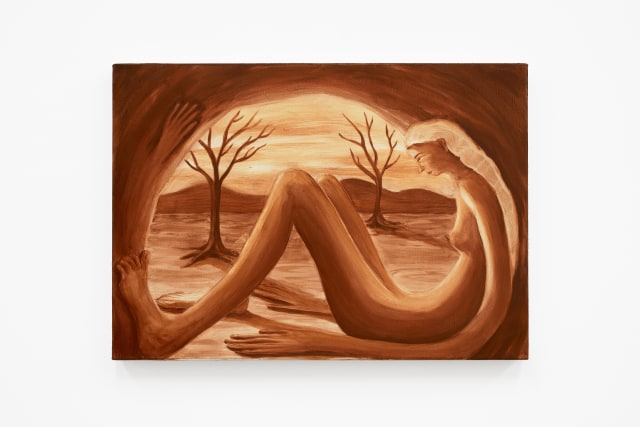Melania Toma
Paula Turmina
Atalanta Xanthe
‘For a long time, he said, you cannot tune in. Then, you might sense a current or buzz of telluric energy. This sound transforms, the more time you spend in caves. It becomes voices. You hear these voices but are unable to isolate them. It takes years to learn how to listen, to differentiate, to adjust your inner tuner to a position on the temporal band-with of the underground world.’
- Rachel Kushner, Creation Lake (2024)
Ione & Mann is thrilled to present The Cave in the Mind, a group show curated by Marcelle Joseph featuring the recipients of the 2024 GIRLPOWER Residency. Bringing together the works of Melania Toma, Paula Turmina and Atalanta Xanthe, The Cave in the Mind presents new work produced at the culmination of these three artists’ stay at the GIRLPOWER Residency in the Aquitaine region of southwestern France.
How did the images painted or engraved in charcoal and red hematite on the walls of caves in Western Europe thirty-five thousand years ago spring, seemingly from nowhere, into the human story? Who made these paintings? And why did they paint only fauna such as bison, horses, ibex, deer, aurochs, woolly mammoths, bears, lions and sabre-toothed tigers? Were these images made as a creative impulse or part of some kind of religious, spiritual or pagan ceremony or ritual? Or were they made as a psychic manifestation of a bounteous upcoming hunting season? Some even say that these artists could have been plotting the stars in the sky, coming up with these animal forms through nocturnal celestial mapping.
In this exhibition, the works originate from a constellation of artists who participated in the 2024 edition of the GIRLPOWER Residency in southwestern France, namely Melania Toma, Paula Turmina and Atalanta Xanthe. Nearby to many cave sites, these three artists had the privilege to visit the caves at Pech Merle, Font-de-Gaume and Combarelles. Deeply moved by what they saw, these artists agreed to come together after the residency to reflect on these works of prehistoric art for this exhibition, The Cave in the Mind.
No one knows why these Homo sapiens crouched and crawled into the deep subterranean vortexes of the limestone caves of southwestern France to make images in the total darkness during the Upper Paleolithic Transition from a Neanderthal to a Homo sapiens populace. But according to David Lewis-Williams (The Mind in the Cave (2002)), during this period, human beings were able to remember their visions, dreams and hallucinations and, with fully modern language, to speak about them. Only after developing a set of socially shared mental images could the people of this period start to make graphic images or fix their visions on the walls of these caves when in an altered state of consciousness caused by sensory deprivation afforded by the remote, silent and totally dark underground chambers. He posits that the people of that period ‘harnessed what we call altered states of consciousness to fashion their society and used imagery as a means of establishing and defining social relationships’. Lewis-Williams looks at the origin of the image-makers in that ‘art cannot be understood outside its social context’. So a two-dimensional image of a bison in a cave was not a depiction of a ‘real’ bison but a ‘vison’, a ‘spirit bison’. Thirty-five thousand years ago, image-makers were shamans, not artists.
The three artists in this exhibition may not be hunter-gatherer shamans or celestial mappers, but they all were deeply touched by what they saw in the caves they visited this past summer in southwestern France, including the polychrome paintings of bison, horses and mammoths at Font-de-Gaume, the engravings of horses, reindeer, ibex, rhinoceros, bears and lions at Combarelles and the prehistoric negative handprints at Pech Merle. In that vein, some of the featured artists have made works that allude to these cave paintings and their predetermined vocabulary of motifs, and others have created works that imbue the ambience of being in those sacred places of rituals.
If we go back to the conclusions of Lewis-Williams, Toma, Turmina and Xanthe are image-makers inspired by their own dreams and visions after witnessing the ‘spirit animals’ made real by these hunter-gatherer shamans. From the rock walls of these dark caves to the white walls of the modern-day gallery space, these artists have translated a shamanistic conception of the world and created artworks that reflect upon the new spiritual dawn that occurred at these Ice Age cave sites in southwestern France.
In the creation of the works in this exhibition, the artists tuned into what Rachel Kushner describes in her 2024 novel Creation Lake as ‘cave frequencies [that] cross moments, eras, epochs, eons’ and ‘tease apart the mono-phony…[to] encounter an extraordinary polyphony’.
‘You hear whispers, laughter, murmurs, pleas. There’s a feeling that everyone is here. A wonderful feeling, I should add. Because suddenly you realize how alone we have been, how isolated, to be trapped, stuck in calendar time, and cut off from everyone who came before us.’
Text written by Marcelle Joseph



